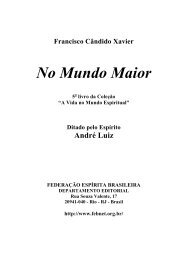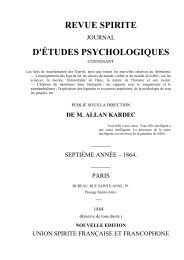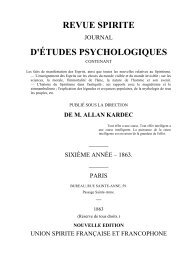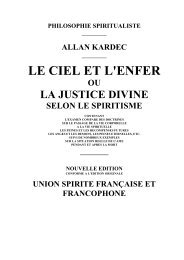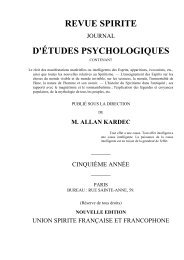PDF version - Geae
PDF version - Geae
PDF version - Geae
Create successful ePaper yourself
Turn your PDF publications into a flip-book with our unique Google optimized e-Paper software.
Today it is not enough just to believe; one wants to understand. No philosophical or moral conception<br />
has a probability of triumph if it does not have for its basis a demonstration that is at the same time logical,<br />
mathematical, and positive, in addition to being crowned by a sanction that satisfies all our instincts of justice.<br />
“If a mathematician wanted to write about philosophy and morals using mathematical formulas, he<br />
could without obstacle do it.” Said Leibniz.<br />
However, adds Leibniz: “It has rarely been tried, and much less with good results.”<br />
It should be observed that these conditions were perfectly accomplished by Allan Kardec in his<br />
magisterial exposition made in “The Spirits’ Book.”<br />
That book is the result of an immense work of classification, coordination and elimination that had for<br />
its basis millions of communications and messages obtained from different origins, each one unknown to the<br />
others. These messages were obtained from all points of the world and assembled together by the eminent<br />
compiler, after establishing their authenticity. He was careful to set aside any isolated opinions, and suspect<br />
testimonies, keeping only the points where the statements were in agreement.<br />
There is still much to be added before this work is complete. Despite the death of its brilliant initiator,<br />
this work has not suffered interruption. In fact, we already possess a powerful summary whose main lines were<br />
drawn by Kardec himself. Now, the heirs of his thoughts in conjunction with the invisible world are making an<br />
effort to further develop it. Each one brings his grain of sand for the common establishment of this edifice,<br />
whose fundamentals scientific experimentation renders more solid every day, and whose adornments will<br />
enable it to rise taller day by day.<br />
For thirty uninterrupted years I myself received teachings from spiritual guides, who relentlessly<br />
provided their assistances and advices. Their revelations proceeded to take on a particularly didactic character<br />
during the sessions that lasted eight years, and of which I wrote about in a prior work 9 .<br />
In Allan Kardec’s book, the teachings of the spirits are accompanied, on each question, with a<br />
consideration, commentary, and clarification. His style makes clear the beauty of its principles and the<br />
harmony of its whole. It is there that the qualities of the author become evident. First, he cleverly provides a<br />
clear and precise meaning of the expressions he often employed in his philosophical argumentation. Then, he<br />
proceeds to clarify the terms whose meanings could be interpreted in different ways. He knew that the<br />
confusion that arises in most philosophical systems is the result of a lack of clarity of expressions used by the<br />
authors.<br />
Another rule of equal importance used throughout the entire methodic exposition, and one that Allan<br />
Kardec meticulously observed is that which consists of circumscribing the ideas, and presenting them in a way<br />
that enables the readers to better understand them. Next, he developed those ideas in an orderly fashion and<br />
correlated them so as to promote their interconnection. Finally, he knew how to draw conclusions that already<br />
represent a reality and a certainty within the rational order, and in accordance with human conceptions.<br />
For the above reasons and for the purpose of safety, we propose to adopt the terms, the views, and the<br />
methods observed by Allan Kardec for this book. We have added to our work all developments resulting from<br />
the investigation and experiences that took place during the fifty-year period since the appearance of his<br />
works.<br />
In view of the above validation, we see that the Doctrine of the Spirits (of which Kardec was the<br />
interpreter and judicious compiler), similarly to the most appreciated philosophical systems, encompasses the<br />
essential qualities of clarity, logic and rigor. Unlike any other system, however, the Spiritist Doctrine offers its<br />
vital set of manifestations, through which it first affirmed itself in the world. Since its establishment the<br />
Spiritist Doctrine has continuously withstood all kinds of examinations. It addresses people of all social classes<br />
and conditions; it speaks not only to their senses and intellects, but especially to their best possessions - reason<br />
and conscience.<br />
Do not these inner potencies, in their union, constitute a criterion of good and evil, truth and<br />
falsehood, more or less clear or concealed, evidently in accordance with the advancement of the soul? Further,<br />
don’t we find that each of these is a reflection of the Eternal Reason from which they emanate? 10<br />
9 See Dans I’Invisible, pg. 299 on.<br />
10 Facts do not have value without the reason that analyzes and deduces from them the law. Phenomena are ephemeral; the certainty they give us<br />
is only apparent and without duration. Only the Spirit possesses certainty, absolute truths are of a subjective order, and History shows it.<br />
Through the centuries it was believed, and many still believe, that the Sun is born every day. It was necessary to discover through intelligence the<br />
movements of the Earth, imperceptible to the senses, in order to understand the return of the same points to the same position in relation to the sun.<br />
24



